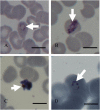Molecular typing reveals substantial Plasmodium vivax infection in asymptomatic adults in a rural area of Cameroon
- PMID: 24886496
- PMCID: PMC4032583
- DOI: 10.1186/1475-2875-13-170
Molecular typing reveals substantial Plasmodium vivax infection in asymptomatic adults in a rural area of Cameroon
Abstract
Background: Malaria in Cameroon is due to infections by Plasmodium falciparum and, to a lesser extent, Plasmodium malariae and Plasmodium ovale, but rarely Plasmodium vivax. A recent report suggested "Plasmodium vivax-like" infections around the study area that remained unconfirmed. Therefore, molecular and antigenic typing was used to investigate the prevalence of P. vivax and Duffy in asymptomatic adults resident in Bolifamba.
Methods: A cross-sectional study was conducted from July 2008 to October 2009. The status of all parasite species was determined by nested PCR in 269 blood samples collected. The P. falciparum and P. vivax anti-MSP/CSP antibody status of each subject was also determined qualitatively by a rapid card assay. Parasite DNA was extracted from a sample infected with three parasite species, purified and sequenced. The Duffy antigen status of 12 subjects infected with P. vivax was also determined by sequencing. In silico web-based tools were used to analyse sequence data for similarities and matches to reference sequences in public DNA databases.
Results: The overall malaria parasite prevalence in 269 individuals was 32.3% (87) as determined by PCR. Remarkably, 14.9% (13/87) of infections were caused either exclusively or concomitantly by P. vivax, established both by PCR and microscopic examination of blood smears, in individuals both positive (50%, 6/12) and negative (50%, 6/12) for the Duffy receptor. A triple infection by P. falciparum, P. vivax and P. malariae, was detected in one infected individual. Anti-MSP/CSP antibodies were detected in 72.1% (194/269) of samples, indicating high and continuous exposure to infection through mosquito bites.
Discussion: These data provide the first molecular evidence of P. vivax in Duffy positive and negative Cameroonians and suggest that there may be a significant prevalence of P. vivax infection than expected in the study area. Whether the P. vivax cases were imported or due to expansion of a founder effect was not investigated. Notwithstanding, the presence of P. vivax may complicate control efforts if these parasites become hypnozoitic or latent as the liver stage.
Conclusions: These data strongly suggest that P. vivax is endemic to the south-west region of Cameroon and should be taken into account when designing malaria control strategies.
Figures





References
-
- WHO. Fact Sheet N° 94. Geneva: World Health Organization; 2013. http://www.who.int/mediacentre/factsheets/fs094/en. (Reviewed, March 2013. Last accessed: September 3, 2013)
-
- CDC. 2013. http://www.cdc.gov/malaria/malaria_worldwide/impact.html. (Last accessed: September 3, 2013)
-
- Malaney P, Speilman A, Sachs J. The malaria gap. Am J Trop Med Hyg. 2004;71(Suppl 2):141–146. - PubMed
-
- WHO. Malaria: Research results, No 38. Geneva, Switzerland: World Health Organization/TDR Report; 2001.
Publication types
MeSH terms
Substances
Grants and funding
LinkOut - more resources
Full Text Sources
Other Literature Sources
Medical
Research Materials

